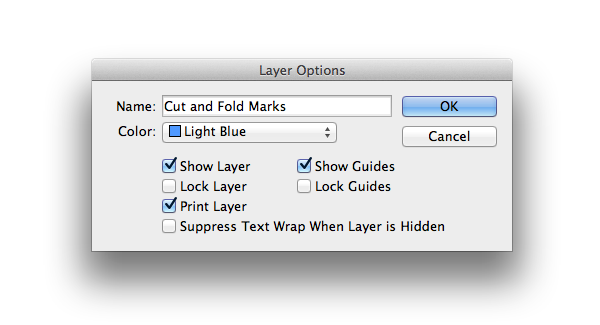
This is a fun tutorial, and glitter is more than encouraged for adding that final glam touch to the cards! We’ll be using Adobe InDesign, but we’ll also do a bit of image editing using Illustrator. You’ll also need access to an A4 color printer (or a friendly professional printer!), as well as scissors, a craft knife, and some optional glitter or glitter glue.
Once you’ve set up the basic layout of the cards you can experiment with different colours and typefaces to match the theme or decor of your dinner table. We'll look at some design rules to follow when designing your own cards, and show you another design example to imitate, which has a more festive, high-contrast look.
1. Prepare the Layout of Your Party Cards
We’ll set up the cards to print on an A4 sheet. Most home printers don’t print to the very edges of the page, so we’ll take this into account when we prepare the layout.Step 1
Open InDesign. Select New Document from the Welcome window or go to File > New > Document.
Step 2
In the New Document window, keep the Intent as its default setting, Print, and set the No. of Pages to 2. Uncheck Facing Pages.From the Page Size drop-down menu select A4 and switch the Orientation to Landscape by clicking the right-hand icon.
Adjust the Number of Columns to 2 and increase the Gutter (space between the columns) to 10 mm.
Set the Margins on all sides to 5 mm, and include a Bleed of 3 mm on all sides, if you’re intending to send the cards out to a professional printer.


Step 3
Each card will be 110 mm in Width and 50 mm in Height once folded. So, the entire dimension of one card when laid out flat will be 110 mm in Width and 100 mm in Height.We can introduce some guides to make laying out multiple cards to each page much simpler. Navigate to the A-Master, by double-clicking on the A-Master page icon in the Pages panel (Window > Pages).
First, drag a vertical guide from the left-hand ruler (View > Show Rulers, if not visible by default) to the center point of the page, at 148.5 mm. Drag a second guide, this time from the top ruler, to the horizontal center of the page, at 105 mm.
These useful guides will be applied to all pages which have the A-Master applied to them, which by default is currently both pages of your document.

2. Pop-Up Cards With Hand-Drawn Snowflakes
Step 1
Open the Layers panel (Window > Layers) and double-click the default Layer 1 name. In the Layer Options window, rename the layer Cut and Fold Marks.
Step 2
Navigate to Page 1 of your document, remaining on the Background layer.Select the Rectangle Tool (M) and drag to create a frame 110 mm in Width and 100 mm in Height. Position this to the top left of your page, resting the lower edge on the central guide, and the right edge against the edge of the left-hand column, as shown.


Step 3
Now it’s time to apply some color to the background of your cards. The decorative elements of the cards are going to be pulled out in white and pale grey, so choose colors that will provide some contrast.Here I’ve used a pale blue and a charcoal grey to keep the colors of the card looking rustic and muted.
Open the Swatches panel (Window > Color > Swatches) and click the New Swatch icon at the bottom right of the panel. Add the following CMYK swatches to the set of colors:
- C=47 M=6 Y=9 K=0
- C=65 M=46 Y=37 K=23

Step 4
Return to the Layers panel and Lock the Background layer. Unlock the Cut and Fold Marks layer.Remaining on Page 1 of the document, select the Line Tool (\) and, holding down Shift, drag from left to right to create a short straight line, about 11 mm in Width. Set the Width of the Stroke (either from the top control panel, or the Stroke panel [Window > Stroke]) to 0.25 mm.
Position the line to the left of the page, resting it along the central horizontal guide.
Select the line and Edit > Copy and Edit > Paste. Manoeuvre this second line into a mirrored position on the right hand side of the page.
These lines indicate where the cards will need to be cut.

Step 5
Remaining on the Cut and Fold Marks layer, select the Line Tool (\) as before and, holding down Shift, drag from left to right to create a straight line, about 11 mm in Width.Adjust the Stroke Weight to 0.1 mm, Type to Dashed and Stroke Color to [Paper]. Position this across the center of one of the cards.
Select the line and Edit > Copy, Edit > Paste three more times, positioning each meeting across the horizontal center of each card.
These lines indicate where the cards will need to be folded.

Step 6
Return to the Layers panel and Lock the Cut and Fold Marks layer. Create a new layer, and rename it as Snowflakes. Position it above the Background layer.
Step 7
Keeping your InDesign document open (and saving it for good measure!), open Adobe Illustrator.Go to File > Open and select a vector image of snowflakes, like this one from PhotoDune.
Isolate one of the snowflakes, editing it on a fresh Illustrator artboard.
Select the vector and open the Brush Definition drop-down menu from the top control panel. Click the Brush Libraries Menu icon at the bottom left corner of the menu and select Artistic > Artistic_ChalkCharcoalPencil. Apply Pencil - Thick to the vector, adjusting the Stroke Weight to 2 pt.


Step 8
Return to your InDesign document.Remaining on Page 1 and on the Snowflakes layer, select the Rectangle Frame Tool (F) and drag to create a small square frame about 40 mm in diameter.
Go to File > Place and select the EPS snowflake image. Click Open. Select Fill Frame Proportionally from the top control panel to arrange the image nicely in the frame.
Using the Free Transform Tool (E) you can also rotate the frame a little to give it a slightly jaunty angle. Position the image frame centrally on the fold line of the top left card.



Step 9
Return to the Layers panel and Lock the Snowflakes layer, and Unlock the Cut and Fold Marks layer.When the cards are cut and folded, we want the snowflakes to pop up over the edge of the fold, as shown here.

Navigate to the top left card on Page 1 and select the Pen Tool (P). Giving yourself a small margin proud of the edge of the snowflakes, click sparingly around the perimeter to create a cut line stretching from the fold line on the left side to the fold line on the right edge.



Step 10
We can now introduce some typography to the cards, and you can start to personalise the designs with the names of your guests!In the Layers panel, Lock the Cut and Fold Marks layer and select the Create New Layer icon. Rename this new layer Typography.
As the card design has a hand-made, rustic look, you should pick a font that looks equally charming. A handwritten, chalky font like Chalk Hand Lettering Shaded will work a treat.
Select the Type Tool (T) and drag to create a text frame 110 mm in Width and 17 mm in Height. Type ‘Name’ and set the Font to Chalk Hand Lettering Shaded, Size 60 pt and Align Center. Set the Font Color to C=65 M=46 Y=37 K=23.


Step 11
As a final step, Lock the Typography, Snowflakes and Cut and Fold Marks layers. Drag your mouse across the whole of Page 1 to select the colored frames and Edit > Copy.Navigate to Page 2 of the document and Edit > Paste in Place. If you print the cards double-sided, this will ensure that the insides also have stylish colored backgrounds.

3. Prepare Your Cards for Print
Step 1
Once you’re happy with the InDesign artwork you can export the cards to PDF for print.For printing at home, go to File > Export, selecting Adobe PDF (Print) from the Format drop-down menu in the Export window. Select Press Quality from the Adobe PDF Preset drop-down menu, and ensuring All is checked under the Pages options.

Step 2
If you’re sending the cards to print at a professional printers, you should check All Printer’s Marks and check Use Document Bleed Settings under the Marks and Bleeds options (accessible from the left-hand menu).
4. Why Not Try Out a Different Style?
Place cards are a great canvas for all sorts of designs. You should match your choice of typefaces and colors to the scheme of your dinner setting, or give the cards a theme if you’re hosting a themed party.Once you have the layout of the cards prepared, as detailed above in Section 1 of the tutorial, you can get experimental with your design choices. Throwing a lavish Great Gatsby-inspired affair? Try introducing an Art Deco frame and gold detailing on your cards. How about a stylish event inspired by Truman Capote’s famous ‘Black and White’ Ball? Apply monochrome detailing for contrast and an elegant serif typeface for added elegance.
The options are endless, and it comes down to your personal preferences. Just remember to keep these simple rules in mind:
- Use a typeface which matches the feel of your event (elegant, playful, or minimally modern) and make sure it’s legible at small scale (no one wants to be having to squint to read where they’re meant to be sitting!).
- Use color contrast to draw attention to the text (see the example design below).
- Include images sparingly. Silhouettes and simple shapes look best and won’t compete with the text.
- Make sure your text and images will be centered or appear symmetrical once the cards are folded.
- Have fun! Choose designs that will make people smile or will give your guests the impression that an extra special effort has been made. Everyone loves to feel special at an event, and named place cards are a great way of doing this.


Use bold colors with a wintery feel, like Moss Green (C=61 M=42 Y=100 K=36), a Deep Purple-Blue (C=76 M=72 Y=41 K=37), Cranberry Red (C=22 M=92 Y=100 K=14) and Coal Black (C=75 M=64 Y=67 K=83).
For the names, use an elegant serif typeface with italic characters that merge into each other seamlessly. The font Great Vibes would be a great choice.

Your Cards Are Looking Awesome!
Once your cards are printed, all you need to do now is whip out the glitter glue and add a few touches of wintery sparkle. Beautiful!




.webp)
